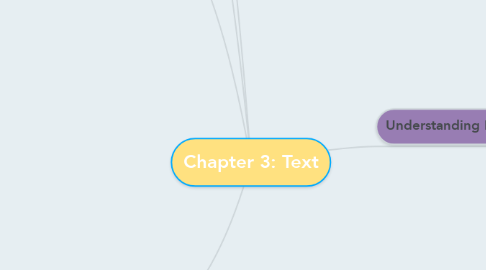
1. Text Elements
1.1. Menus for navigation
1.1.1. user navigates through content using a menu
1.1.2. simple menu consists of a text list of topics
1.2. Interaction Buttons
1.2.1. button is a clickable
1.2.2. create their own buttons from bitmaps and graphics
1.3. Symbols and icons
1.3.1. concentrated text
1.3.2. stand-alone graphic constructs
1.3.3. convey human emotions are called emoticons
1.4. Fields for reading
1.4.1. hard copy, faster than reading from the computer screen
1.4.2. printed one of two orientations: portrait or landscape
1.4.2.1. taller-than-wide is portrait
1.4.2.2. wider-than-tall is landscape
1.5. HTML documents
1.5.1. Hypertext Markup Language
1.5.2. language used to create web pages
1.5.3. marked using tags
1.5.4. DHTML
1.5.4.1. static HTML
1.5.4.2. Javascript
1.5.4.3. Cascading Style Sheets(CSS)
1.6. commonly
1.6.1. <B>: text boldfaced
1.6.2. <OL>: ordered list
1.6.3. <IMG>: images
2. Computers and Text
2.1. Bitmap font and Vector font
2.1.1. bitmap font : dots or pixels representing the image
2.1.1.1. file size increases as more sizes are added
2.1.1.2. require a lot of memory
2.1.1.3. non-scalable
2.1.2. Vector font: mathematical formulae to describe each glyph
2.2. Rasterization
2.2.1. converting text from vector to raster or bitmap description
2.2.2. jaggies
2.3. Anti-aliasing
2.3.1. font into the background color
2.4. Character sets
2.4.1. ASCII is the numerical representation of a character
2.4.2. 7-bit binary code word, 128(2^7) alternative characters
2.5. Extended Character Set
2.6. Unicode
2.6.1. 16-bit architecture for multilingual text
2.6.2. cover 96,382characters
3. Font Mapping
4. Hypertext vs Hypermedia
4.1. Hypertext
4.2. Hypermedia
4.2.1. structures
4.2.1.1. Links
4.2.1.2. Nodes
4.2.1.3. Anchors
5. Understanding Fonts and Typefaces
5.1. Typeface
5.1.1. family of graphic characters, often with many type sizes and styles
5.1.2. Example: Bookman Old Style
5.2. Font
5.2.1. a collection of characters of a single size and style belonging to a particular typeface family
5.2.2. Example: Arial 18 point Bold
5.3. Font styles
5.3.1. Boldface
5.3.2. Italic
5.3.3. Underlining
5.3.4. Outlining
5.4. Font Terminology
5.4.1. Baseline
5.4.1.1. charters are arranged
5.4.2. Cap height
5.4.2.1. height of a capital letter
5.4.3. x-height
5.4.3.1. lower-case letter x
5.4.4. Ascenders/ Descenders
5.4.4.1. x-height/ drop below the baseline
5.4.5. Kerning
5.4.5.1. space between certain pairs
5.4.6. Tracking
5.4.6.1. space for groups
5.5. Serif versus sans serif
5.5.1. serif
5.5.1.1. used for printed media
5.5.2. Sans serif
5.5.2.1. do not have decoration
5.6. Cases
5.6.1. Capitalized letter: uppercase: Small letter: lowercase
5.6.2. placing an uppercase letter in the middle of a word is intercap or CamelCase
